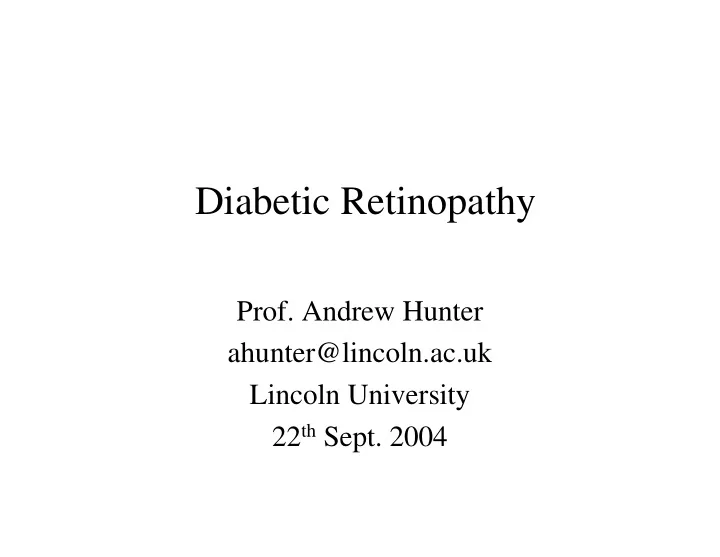

Diabetic Retinopathy Prof. Andrew Hunter ahunter@lincoln.ac.uk Lincoln University 22 th Sept. 2004
Diabetic Retinopathy • The leading cause of blindness in the developed world – Several million diabetics require annual screening in the UK alone • Primary indictor: small “dots and spots” on special retinal photographs • Vascular changes – beading and neovascularization • Macula Oedema – swelling (discoloration and surface shape)
Diabetic Retinopathy
A Haemorrhage in detail
Peak points
Circular Peak Points
Lesion Growing
An algorithm to find dark lesions • Extract features (measurements) • Contrast, shape, size, blurriness, etc. etc. • Feed these measurements to a neural network which learns to distinguish lesions from distractors
Feature Selection Method • Use of sensitivity analysis for classifier inputs • Exploits “missing value substitution” procedure • Ratio of performance with and without available information • Hierarchical feature selection
Optic Nerve Head segmentation • Interesting problem in deformable modelling • Fundamental shape is fairly simple – elliptical with vertical major axis • Overlapping blood vessels • Presence of pallor and peri-papilliary atrophy distractors
Sample Optic Nerve Heads
The Algorithm • Global/local deformable model • Global model – fixed aspect ratio ellipse • Local model – distortions away from this • Spokes projected at 15 degree angles • Attractor points at maximum coincident gradients (or second order local gradient) • Balance of global, local, smoothing forces
The Deformable Model
The stages • Fit global model against temporal sector of ONH only (temporal lock phase) • Fit global model against whole ONH • Let the local model loose to fit the full model
Vascular Measurement • Changes in widths of vessels are very diagnostic • Typical vessels no more than 6-8 pixels wide • Require width measurements to sub-pixel accuracy
Vascular Model • A gaussian extruded forms a reasonable shape model for a vessel • A difference of gaussians models specular highlights
A vessel profile
Vascular Model
Sub-pixel accuracy • Deformable models like this can fit boundaries to sub-pixel accuracy • Exploitation of anti-aliasing effect • Human beings do this routinely – That’s how a television works! • Accurate to at least 0.34 pixels on our tests • Used high-resolution images rescaled for the algorithm (by a factor of 4).
Algorithm at work
Real World Use? • Sensitivity / specificity for Sight Threatening Retinopathy – Lesions near to the macula • 97% sensitivity (one error), 75% specificity • This is still insufficient! – why? – Unanticipated disease conditions – Severe disease conditions • Planning use in audit rather than automated screening
Recommend
More recommend